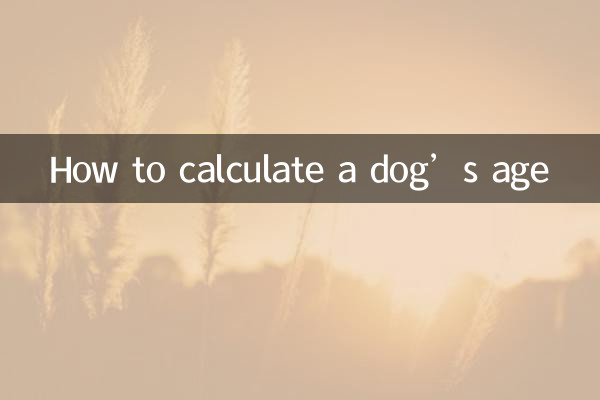How to calculate a dog’s age
Calculating the age of dogs has always been a topic of concern to pet owners. Unlike humans, the age of dogs is not a simple 1:7 ratio (that is, 1 dog year is equal to 7 human years), but varies according to size, breed and life cycle stage. The following is the scientific method and structured data on dog age calculation that has been a hot topic on the Internet in the past 10 days.
1. Scientific basis for calculating dog age

In 2020, a research team from the University of California, San Diego proposed a more accurate formula for calculating dog age based on DNA methylation levels, breaking traditional knowledge. Research shows that dogs age faster when they are young and then gradually slow down as adults.
| dog age | Small dogs (human age) | medium sized dog (human age) | Large dogs (human years) |
|---|---|---|---|
| 1 year old | 15 years old | 15 years old | 14 years old |
| 2 years old | 24 years old | 24 years old | 22 years old |
| 3 years old | 28 years old | 29 years old | 31 years old |
| 5 years old | 36 years old | 40 years old | 45 years old |
| 7 years old | 44 years old | 50 years old | 56 years old |
| 10 years old | 56 years old | 66 years old | 78 years old |
2. Differences in aging among dogs of different sizes
1.small dog: Such as Chihuahuas, Poodles, etc., usually live longer (12-16 years), but age faster in the first two years.
2.medium sized dog: Such as corgis, beagles, etc., their life span is about 10-14 years, and their aging curve is relatively stable.
3.large dogs: Such as golden retrievers, German shepherds, etc., have a short lifespan (8-12 years), and aging is significantly accelerated after the age of 5.
| body shape | life expectancy | Accelerated aging period |
|---|---|---|
| Small dogs (<10kg) | 12-16 years old | 1-2 years old |
| Medium-sized dogs (10-25kg) | 10-14 years old | 3-5 years old |
| Large dogs (>25kg) | 8-12 years old | after 5 years old |
3. Practical methods to determine the age of your dog
1.tooth status: The deciduous teeth of puppies erupt at 3-6 weeks, and the permanent teeth are replaced at 4-6 months; the teeth are white at 1 year old, and tartar begins to appear at 3 years old.
2.hair changes: After the age of 7, white hair appears around the mouth and nose, and after the age of 10, the hair all over the body becomes rough.
3.eye condition: The lens of the eyes of elderly dogs is cloudy and cataracts may occur.
| Physiological characteristics | Corresponding age |
|---|---|
| All baby teeth have grown in | 2 months |
| All permanent teeth have grown in | 7 months |
| Slight yellowing of teeth | 1-2 years old |
| Obvious dental calculus | 3-5 years old |
| Severely worn teeth | 7 years old+ |
4. Scientific Suggestions for Extending the Lifespan of Dogs
1.Diet management: Select special food according to age, and elderly dogs need to control their caloric intake.
2.Regular physical examination: After the age of 7, it is recommended to have a physical examination every six months to screen for chronic diseases.
3.moderate exercise: Elderly dogs should maintain low-intensity regular exercise, such as walking twice a day.
4.oral care: Regular brushing can prevent periodontal disease and extend life by 1-2 years.
Through scientific calculations and observations, we can more accurately understand the life stages of dogs and provide more appropriate care. Remember, the age of a dog is not just a number, but also requires us to feel their physical changes carefully.

check the details

check the details